As an Amazon Associate I earn from qualifying purchases.
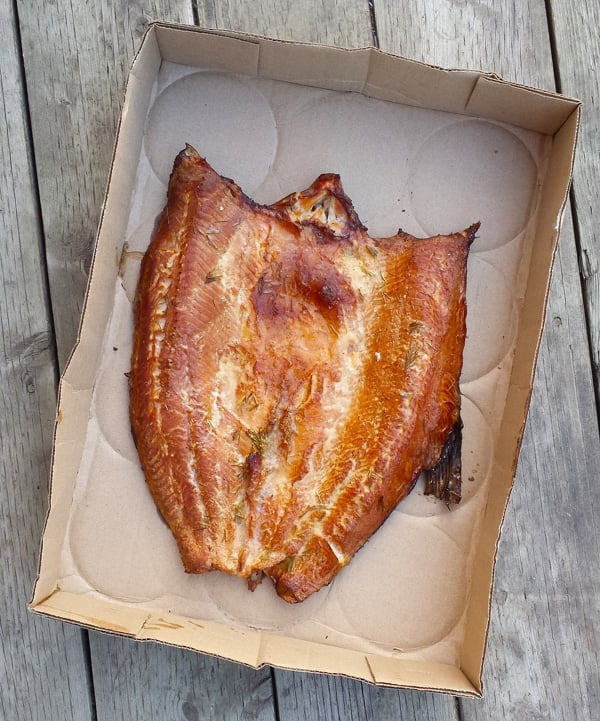
Lake trout, mackinaw, lakers or, for those inclined toward Latin, Salvelinus namaycush, are perhaps the most unloved of the trout family. They’re the only member of this exalted clan routinely denigrated as food. Almost all the complaints take some form of the whiny refrain: “Ew, too greasy!”
Really, folks? Really? I mean, we all love bacon (greasy), and most fish eaters love salmon for its fat — a good piece of smoked chinook salmon will leave your hands slick with yummy orange oil. And what’s more, salmon and trout fat is good for you. Omega-3s, anyone?
That said, I won’t lie to you: Lake trout is a fatty fish. Normal ones range from 5 1/2 percent fat by weight to up to 20 percent, and a subspecies in the Great Lakes called a siscowet can be truly, astonishingly fat: One study conducted in 1965 showed one of these porkers to be 88 percent fat by weight. That one might be too fatty even for me. But a siscowet is a rare laker.
In general, the larger the lake trout the fattier it will be. I’ve found the sweet spot to be somewhere between 24 and 35 inches, generally somewhere between 6 and 15 pounds. Larger lakers tend to be all breeding females anyway and should be released if possible.
If you’re wondering about the odd Latin name for the lake trout, namaycush, it’s a Cree Indian word for the laker that we’ve adopted into the international scientific name. I bring this up because when I first made this recipe I happened to be in Cree Country: Gods Lake, Manitoba in central Canada, as a guest of Travel Manitoba.
When I say the fishing was epic, I am understating things quite a bit. In two days of fishing for them, I caught 37 lake trout, none smaller than 22 inches, which is about 4 1/2 pounds, up to 32 inches, which is almost 15 pounds. Perfect for smoking!

You can only keep one fish a day there, so we fished with barbless hooks (which is the law in Manitoba) and released almost all of them. What’s more, Elk Island Lodge, where we were staying, doesn’t allow you to take any fish home, so we had to do our smoking at the lodge.
This actually turned out to be a good thing.
The local Cree, many of whom live in the nearby Gods Lake Narrows, are a woodland band of First Nations people (I kinda like the “first nations” moniker) who’ve been around this part of Manitoba for an awful long time. The lodge hires some Cree guys as fishing guides for the lake, and one of our guides was Robert Spence. Robert is a bit older than I am, and knows his way around cooking fish. So do I, so we had a lot to talk about while trolling for lakers.
My friend and fishing partner, Shel Zolkewich, caught a nice 28-inch lake trout, so we put it on a stringer for smoking later. Robert mostly fillets his lake trout for smoking, but I prefer a Scottish method called kiting, which leaves the fish whole and boneless except for the pectoral fin bones. Kiting — as in a kite — splits the fish down the backbone, leaving the belly intact.
If you know how to butterfly a fish, it’s like that, only from the opposite side of the fish. I prefer kiting with fatty salmon and trout because that belly meat is so fatty and good, I don’t want to slice into it until the meat’s been properly smoked.
Once kited, I heavily salted both sides of the trout and then sprinkled over a bunch of spruce tips that happened to be growing next to the cabin. Spruce tips (or fir tips), if you’ve never used them, are piney and citrusy all at once. They are perfect for fat salmon or trout because they cut some of that fattiness. I then folded the fish back together and set it to cure in the fridge for a few hours.
Then Robert took over.
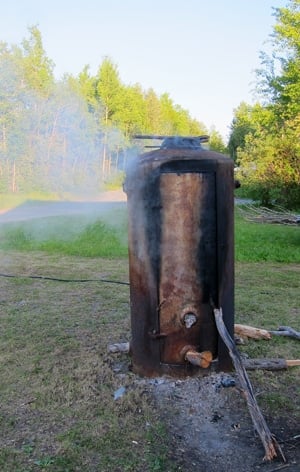
He’s made a smoker from an old boiler salvaged from an abandoned gold mine (Gods Lake had a little gold rush almost a century ago), which was pretty cool, but what was really cool was the wood he used. Even though we were in the boreal forest and alder and birch were everywhere, Robert went off looking for just the right wood.
He came back with a huge stash of what he called diamond willow, which so far as I could tell is either peachleaf willow (Salix amygdaloides) or black willow (Salix nigra) that has been infected with a particular fungus that causes diamond-shaped cankers on the wood. Robert said this willow gives the fish much more flavor than any other kind of wood locally available.
In went the fish, and a few hours later we brought the smoked lake trout back to the cabin on an old cardboard can carton. It felt like delivering a pizza, so we called it Cree pizza the whole trip.
It was much better than pizza. The trout was heavily smoky, and the willow flavor was much more pronounced than I’d expected it to be; it was almost like walnut. You could taste the spruce tips as a bright note, but mostly this was all about smoky, meaty awesomeness. We hammered that trout that first night, but it was so big we managed to pick at it all weekend. I even had a little left for the flight home.
I was eating some, fingers glistening, when I noticed the guy in the seat next to me looking envious. I gave him a chunk. “Oh my God, where did you buy this?” he asked. I told him I didn’t. I made it. And so can you.
If you are looking for a more standard way to smoke salmon or lake trout, follow this recipe.
Smoked Lake Trout
Ingredients
- 1 whole lake trout, butterflied or kited
- Kosher salt, about 90 grams or 3 ounces, about 1/2 cup
- 1/2 cup chopped spruce tips or fir, or fresh rosemary
- Grated zest of an orange or 2 lemons or limes (optional)
Instructions
- Salt both sides of the trout liberally. Use the whole 1/2 cup for a fish that, when it was alive, weighed between 5 and 12 pounds. Scale the salt up or down if your fish is larger or smaller, but don't get all hung up on it -- this is an approximation. Sprinkle the chopped spruce tips all over the meat side of the trout. Fold the trout over on itself so it's "back to normal." Put the fish in a closed container and set in the fridge for as many hours as the butterflied fish weighs.
- Rinse off the cure under cold water and pat the fish dry with paper towels. Let it sit out in a cool, breezy place for a few hours, or you can set the trout on a cooling rack in the fridge for up to a day. This dries the fish out enough to form a pellicle; if you skip this step the smoke will not adhere to it as well.
- Smoke the trout over whatever wood you want. We used diamond willow in Manitoba, but alder is my wood of choice for fish. Fruit woods and oak are other good choices. Smoke over low heat -- no higher than 225°F and ideally closer to 180°F -- until the fish has been cooked through, which can take as little as 90 minutes or as long as 4 hours, depending on how thick your trout is and how hot your fire is. Either eat the trout on the spot or let it cool and eat it cold. It should keep for a solid week to 10 days if kept cool.
Notes
Nutrition
Nutrition information is automatically calculated, so should only be used as an approximation.


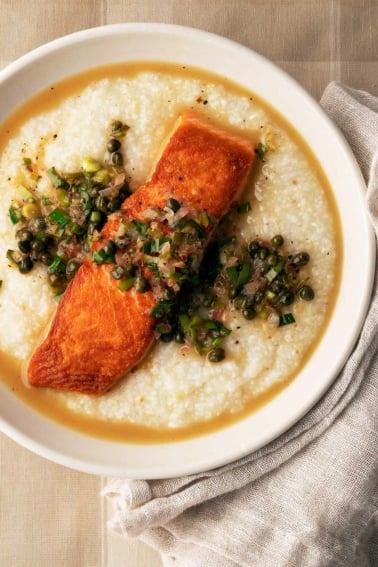
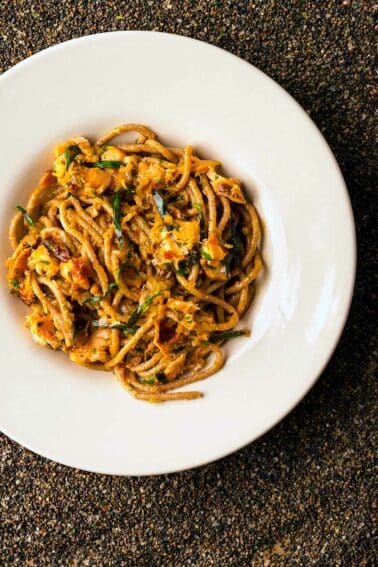
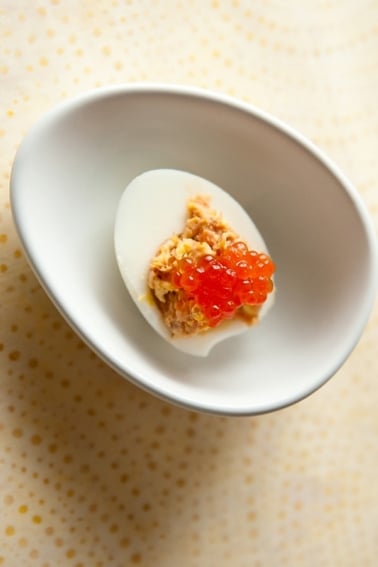
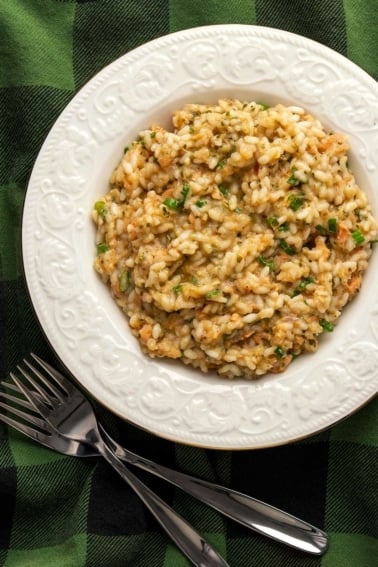
Hey Hank. Just found your recipe on Lakers. I have 2 left in the freezer to smoke in my new Bradley smoker.
I’ve done a bunch of trout, now for the lakers. Thanks for the recipe- like the idea of spruce tips, but will have to make due with rosemary and citrus rind. Cool Beens!!
Thanks for the ideas
Daryl
Thanks Hank !!! I used this same recipe for smoked trout last year and my wife and I both liked it a LOT..!.! Just brought home two nice lakers today from Cayuga Lake (Finger Lakes of western, upstate N.Y.). They were both in that sweet spot range and they are brining with the spruce tips now. Thought I would let you know your time spent sharing your knowledge and tips were much appreciated by another hunter/ fisher/ gatherer// gardener. Again, Thanks for sharing your recipe….Phil
This was a hit with at a family gathering and it beat out my brother-in-law’s recipe, even he admitted it!
First time smoking lake trout and this recipe came out amazing. Simple process to follow…can’t wait to have it with breakfast
Have you tried this with Steelhead?
Chris: Yep. It’s damn good.
Has anyone used blue spruce tips?
John: I have. They’re good.
Ice fishing friends of ours give us their lake trout. They won’t eat them. Say they are too greasy. We love oily fish and this treatment rendered the fillets (they were cleaned from the belly, so, couldn’t kite them) tender and not greasy at all. Our yard has many balsam firs, so tips were easy to get. I rigged a rack in our wood heating stove in the living room and smoked the fish right in it. Results were ambrosia!! Thanks for the great recipe.
I caught a small Mackinaw in a high country lake yesterday. (18 inches long) It is cleaned and currently frozen. They are fairly rare in this lake (you can only have two). Husband wants to smoke it, but it is probably pretty lean already because it’s smaller.
(? true) The ginger-soy sauce recipe sounds great, but any advice on cooking the smaller ones would be appreciated.
Mary: I’d grill it.
Try smoking averaged sized trout stuffed with Oregano and chives with slices of lemon in the middle of the stuffed gut area, smoke with the fish not butterflied so together on its side. I lightly use a rub mixture inside gut cavity before stuffing it. Smoke it at 220F for about an hour for medium sized, I use a Bradley and love it. It honestly comes out so different in taste and sweet. I used to do it this way in NZ then forgot about it, found it on a site a year ago.
To the lady who wants to build a fish smoker, as a Kiwi its not hard, lots of sites will help with info on it, just depends on how big in what you can use.
Hi Hank – I was wondering if you were able to give any info on how to build a fish smoker, it looks fantastic! Cheers from New Zealand!
Hey Hank, didn’t you get the memo? Fat is out of the dog house now, even saturated fat! Carbohydrates and sugar are the new bad boys of food! So yeah- eat away on that good fat! The fattier the better in my opinion. But should you want a credible source check out Dr. Pulmutter at grainbrain.com. Wishin I was that person in the seat next to you! Ughhh… lucky dog!
Great story too!
L
Thanks and perfect timing. We’ve been trying to think of a different way to smoke some of the mullet we catch. Might even try tamarisk tips in the fish, since I don’t have access to diamond willow, and fresh fig wood in the smoker. If you think that’s a terrible idea, let me know, please!
Can’t say I’ve tried tamarisk tips, but fig wood sounds great!
Hank-
Thanks for bringing some positive attention to the much maligned Lake Trout. It’s also great grilled over a HOT fire that renders some of the fat and caramelizes nicely. A couple of years ago I saw an article written by a Michigan DNR biologist that stated that the Lake Trout of the Great Lakes are genetically identical to Arctic Char, another fatty member of the trout family BUT highly prized for it’s culinary attributes. As with all fatty fish it should be eaten extremely fresh.
Sounds delicious! I catch quite a few lake trout through the ice in my area and there’s an overpopulation of them in my local lake so limits are quite liberal. I’ve had great results smoking them much like you suggested, but haven’t tried spruce tips, I’ll have to give that a shot. Not sure what you did with the heads, but don’t throw the heads away. Use the same cure on the head as on the rest of the fish, and smoke it too. Smoked lake trout cheeks are the best bite of fish I think I’ve ever had!
I like it best just pan fried with Montreal spicy pepper medley. Better than salmon in my opinion. Crispy skin is delicious. Will definitely try this though for smoking some. Thanks for sharing.
My favorite way to eat lake trout is cured with ginger, and soy-sauce, smoked until slightly charred and served over rice, but yours looks great as well.
Hi, can you tell me your ginger and soy sauce recipe, thank you…
frankcarion77@gmail.com
Just caught a nice 33 inch, 15 lb. Makinaw yesterday. Will give this a try!